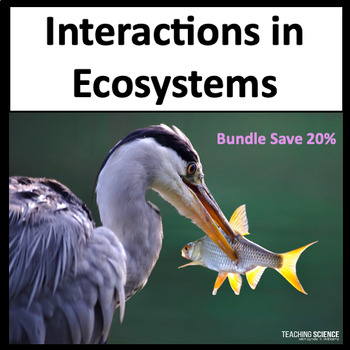Ecosystems Activities & Interactions & Food Webs & Resource Availability
- Zip
What educators are saying
Products in this Bundle (9)
showing 1-5 of 9 products
Bonus
Description
This HUGE Bundle addresses the NGSS MS LS Interactions, Energy, and Dynamics. Students will learn about interactions between organisms, cycling of matter and flow of energy, physical and biological components of an ecosystem, and designing a solution to address an ecological problem.
This Bundle Contains:
- Slide Shows
- Reading Passages
- Response Pages
- Interactive Notebook Inserts
- Labs
- Lab Pages
- Assessments
- Ecosystem Activities
This Ecosystem Bundle Includes:
- Ecosystems Patterns and Interactions
- Ecosystem Food Webs
- Evaluate a Competing Design
- Cycling of Matter
- Ecosystem and Food Web Reading Unit
- Ecosystem Food Sorting Cards
- Field Journal
- Ecosystem in a Jar
- Coral Reef Reading Unit
Teachers Love This Bundle!
Jessica ⭐️ ⭐️ ⭐️ ⭐️ ⭐️ Extremely Satisfied
This resource is everything I was looking for! You name what you need; it is in this bundle! Couldn't have asked for a better resource!
I have combined several resources here to meet all the standards for MS NGSS LS2. This bundle saves you 20% on what the individual resources would cost.
This bundle addresses these standards:
NGSS MS- LS2-1 Analyze and interpret data to provide evidence for the effects of resource availability on organisms and populations of organisms in an ecosystem.
NGSS MS-LS2-2 Construct an explanation that predicts patterns of interactions among organisms across multiple ecosystems.
NGSS MS LS 2.3 Develop a model to describe the cycling of matter and flow of energy among living and nonliving parts of an ecosystem.
NGSS MS LS 2.4 Construct an argument supported by empirical evidence that changes to physical or biological components of an ecosystem affect populations.
NGSS MS-LS2-5.
Evaluate competing design solutions for maintaining biodiversity and ecosystem services.
Also covers the Utah SEEd 6.4 strand
Utah SEEd 6.4.1
Analyze data to provide evidence for the effects of resource availability on organisms and populations in an ecosystem. Ask questions to predict how changes in resource availability affect organisms in those ecosystems. Examples could include water, food, and living space in Utah environments.
Utah SEEd 6.4.2
Construct an explanation that predicts patterns of interactions among organisms across multiple ecosystems. Emphasize consistent interactions in different environments such as competition, predation, and mutualism.
Utah SEEd 6.4.3
Develop a model to describe the cycling of matter and flow of energy among living and nonliving parts of an ecosystem. Emphasize food webs and the role of producers, consumers, and decomposers in various ecosystems. Examples could include Utah ecosystems such as mountains, Great Salt Lake, wetlands, and deserts.
Utah SEEd 6.4.4
Construct an argument supported by evidence that the stability of populations is affected by changes to an ecosystem. Emphasize how changes to living and nonliving components in an ecosystem affect populations in that ecosystem. Examples could include Utah ecosystems such as mountains, Great Salt Lake, wetlands, and deserts.
Utah SEEd 6.4.5
Evaluate competing design solutions for preserving ecosystem resources and biodiversity-based on how well the solutions maintain stability within the ecosystem. Emphasize obtaining, evaluating and communicating information of differing design solutions. Examples could include policies affecting ecosystems, responding to invasive species or solutions for the preservation of ecosystem resources specific to Utah, such as air and water quality and prevention of soil erosion.
Designed to Address Middle School Life Science Standards from the LS2 DCI, Ecosystems, Interactions, Energy and Dynamics:
LS2.An Interdependent Relationships in Ecosystems
LS2.B Cycles of Matter and Energy Transfer in Ecosystems
LS2.C Ecosystem Dynamics, Functioning and Resilience
LS2.D Social Interactions and Group Behavior
These resources are created by Lynda R. Williams at Teaching Science
Follow me and get news of my new resources. Each new resource is discounted by 50% for the first 24 hours!
Created by Lynda R. Williams
Teaching Science With Lynda
Please see my other resources for MS NGSS
Earth's Place in the Universe NGSS Bundle MS ESS1 1-4
NGSS Bundle Weather and Climate for Middle School
Patterns of Interactions of Organisms MS NGSS LS2-1 and MS NGSS LS2-2
Patterns of Interactions in the Ecosystem Utah SEEd 6.4.1 and 6.4.2
Owl Pellet Unit For 6th Grade NGSS MS LS 2.3 and NGSS MS LS 2.4
* My resources are secure and not editable for copyright reasons.





